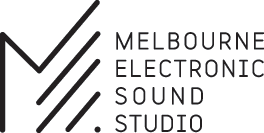Monica Lim
MESS Commissioned Artist, Sonorous VIII – October 2023
Diving deep into the confluence of art, sound, and technology, Monica Lim stands as a unique figure in the world of contemporary sonic expression. With a focus on movement led composition, Monica blends tradition with futurism, orchestrating harmonies and experiences that resonate across disciplines and platforms.
About the commission:
Inspired by working with dancers, Monica uses live keyboard input and computer vision hand gestural controls to choreograph sound in 3-dimensions.
Sounds transform simply through movement, reminding us that sound does not only operate through time, but also space, and challenging our ears to visualise their trajectory. This work uses no prerecorded elements and one MESS instrument – the classic Doepfer A-100.
How did you first get involved with synths and electronic sound?
I learnt classical piano from a very young age, and that musical language was all I knew until I started doing some studies in Interactive Composition at VCA around 2018, where I started learning about DAWs and digital production. My very first experience with synths was in 2019 at MESS, when I was developing the sound for a White Night installation with some collaborators. I remember we used the Prophet to create sounds evocative of brain waves.
How would you describe the sounds you make today?
Extremely varied. I tend to work in multiform contexts so it really depends on the project. A lot of my work is participatory – rather than myself as a performer, I design systems so that audiences can make their own sound, usually using their body or some other input. So the sounds are necessarily indeterminate, ephemeral, responsive. I love unpredictability and the juxtaposition of seemingly incompatible sounds. I like finding bridges between the classical world, the music of my culture and the contemporary world of technology. I like complex rhythms or no rhythms at all. I often work with sound as a signifier of meaning rather than a purely abstract concept – to make installations using neural voices for example. Sometimes I feel more like a theatre-maker than a sound artist.
Where do you find inspiration, what motivates you?
People are the most interesting inspiration for me. How we think, how we feel, why we feel, our interactions with the world, how we respond to change. A particular interest of mine is how people are changed by technology.
I don’t know what motivates me. Curiosity, I think. I have a constant need to learn more things just for the sake of learning them.
What’s been one of the most rewarding or satisfying moments of your journey so far?
The most rewarding thing I’ve done was to build custom musical instruments for
some very special kids with special needs so they could use them for music lessons and music performances. Some of the instruments included an electronic Frog toy, afoot controller and a web-based computer vision harp.
And the most challenging?
I came back to sound-making seriously at quite a late age, after having had many other careers in different fields and when my kids had grown up. So the challenge of starting out with peers who were very much younger was a challenge but also, I think, keeps me young-at-heart and constantly exploring.
Do you have a current ‘go to’ set up at MESS? Any favourite machines or combos that you’re currently digging?
I don’t have too much experience with synths, as I tend to work with digital signal processing. So doing the MESS residency has been a huge learning curve and ear-opener. I immediately gravitated to the Doepfer A-100. Something about its old-schoolness and clean aesthetic just appealed to me. As I work so often in the digital world, I wanted to explore a purely analogue machine. However, I needed a bit of chaos as well, so I added a Benjolin chaos module which a good friend gifted to me a long time ago, and which I’ve never had a chance to explore.
Are there any machines in the MESS collection you’ve had your eye on but haven’t tried yet?
SOOOO many. I would like to explore bringing in real-time audio so I can integrate the acoustic piano into it. I would love to make algorithmic experiments with the Make Noise Maths modules, learn the Ondes Martenot and compose microtonal music for it. I’d love to try the Serge.
If you could give yourself one piece of advice when you first started what would it be?
Don’t think about how, but why. THEN think about how.
Monica performs at Sonorous VIII
Date: Saturday, Nov 4
Time: Two performances 6pm-8pm or 9pm-11pm
Venue: The Substation




